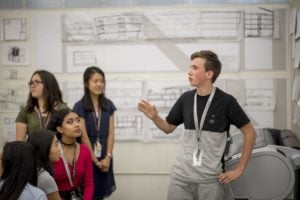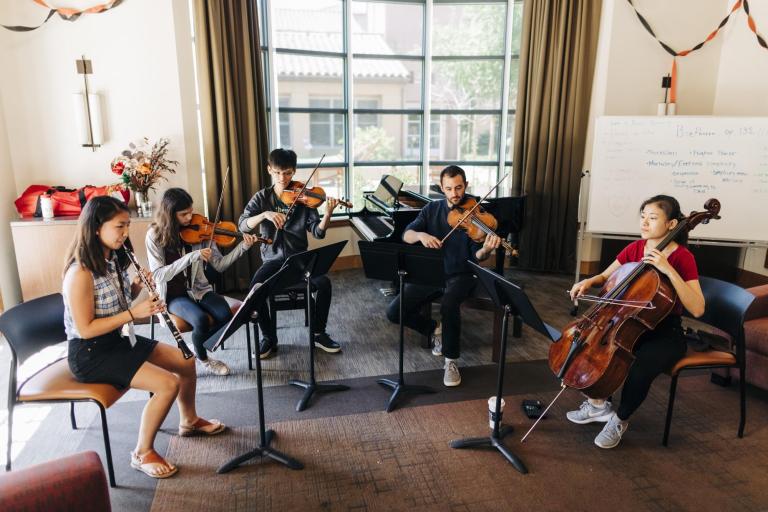Stanford Summer Arts Institute, a summer program for high school students that focuses on studying the intersection of the arts and technology, recently concluded its second session of programming.
The first session of the Summer Arts Institute — which offered courses on “Why Music Matters” and “Architecture and the City” — ran from June 25 to July 14. The second session, which hosted courses on product design and “Music, Technology and Culture,” concluded on Aug. 4.
The Summer Arts Institute was founded by Stanford Pre-Collegiate Studies about three years ago as part of a growing effort to increase artistic educational opportunities on campus.
Mai Mai Cantos, the director of pre-collegiate studies, said that the program’s central goal is to introduce students to the modernization of the arts field.
“The residential division and the academic instruction work together to provide an integrated, residential experience focusing on the arts for high school students,” Cantos said. “The interdisciplinary course focuses on the intersection of art and other areas of study, like technology.”
In addition to introducing students to the crossroads of art and technology, Cantos explained that the Summer Arts Institute also aims to enhance the visibility of artistic opportunities at Stanford. She noticed that in recent years, STEM fields have come to define Stanford, often overshadowing art-related fields.
“Stanford is primarily known for its science and technology, but at its core, it’s a liberal arts school that wants to make sure we develop people who can use creativity to come up with some of the innovations that Stanford is known for,” Cantos said.
Instructor Derek Ouyang also supports the re-integration of art into modern life, as he believes that it is crucial for advancement in the Bay Area. He taught the course “Architecture and the City,” and his central goal was to help students understand the factors that go into designing a city. He said that the younger generations will shape the Bay Area, as it will be their responsibility to develop sustainable, accommodating cities in an era where the Bay Area is rapidly urbanizing and gentrifying. According to him, to build equitable cities, architects need to blend the arts and technology— a synthesis that the Summer Arts Institute champions.

“An [interdisciplinary] approach is important to problem-solving because urban systems and cities are so complex,” Ouyang said. “As a problem solver, [you can’t] confine yourself to only the artistic side of architecture. I try to expose the students to a broader understanding of why cities exist, what kinds of social, environmental and economic challenges cities experience and how building right cities can improve the quality of life.”
Ouyang taught his students to initially rely on creativity for direction, encouraging them to sketch their ideas before delving into the technical aspects of design. He said that traditional hand-drawing is still a very powerful tool in the modern age of architecture. Next, he introduced them to a computer program where they can design their ideas, honing in on precise layout and measurements. According to him, this blend of traditional and modern architectural techniques gave his students a holistic architectural experience.
Ouyang uses a hands-on approach when teaching architecture. For the first two weeks of the three-week course, he organized structured learning time, including lectures and group discussions. For the last week, the students collaborated on a large-scale project, in which they developed a plan to transform a large parking lot near the CalTrain station into a mixed-income neighborhood with a shopping center. He said that the project helped the students understand how many factors go into city design, and how it also encouraged them to blend creative thinking with technological tools.
Instructor Tiffany Naiman also emphasized the importance of versatility between art and technology in her course on music, technology and culture. Her course covered how to use electronic music programs and how filmmakers use music to enhance their movies. Since, traditional music is rapidly being replaced with electronic music, success in the music industry is increasingly reliant upon technological skill.
“If they want to be within the music industry in any shape or form, it’s all about technology,” Naiman said. “Creativity is coming together with a science in music. We don’t just control the technology, but the technology has a major influence on us. To understand that [allows them to] critically think [during the] creative process.”
Naiman’s course also explored how music represents the human experience. Naiman firmly believes that although humanity creates art, art controls society. According to her, understanding the dynamic between the arts and the world is essential to excelling in the arts.
“What’s really important about the Summer Arts Institute is that it puts the arts to the forefront,” Naiman said. “They are a part of our daily life, and we need to be attentive to that fact. Music and culture and technology cross boundaries and we need to understand how those boundaries crossing have an effect on us. I believe that engaging with the arts can make us better humans.”
Naiman wants her students to understand that the arts and technology are rapidly blurring together into a new field. Stanford’s music program itself is at the heart of technology and arts; for example, Stanford’s Center for Computer Research in Music and Acoustics (CCRMA) educates students on how to merge artistic ability with tech savviness in music creation. The center offers computer-music workshops, courses on musical technology and electronic concerts, in order to introduce students to the budding, explosive field of technological music.
Ouyang said that the Summer Arts Institute gives high school students holistic exposure to the evolving arts field and is the perfect preview to interdisciplinary collegiate programs, such as CCRMA. In addition, he noticed that the Summer Arts Institute allows students to independently discover their passions, without overbearing parents controlling their decisions.
“They break out of their bubble,” Ouyang said. “[The Summer Arts Institute] helps them make the right decisions, so they’re not just studying for the tests and taking the things they think will look good on an application, but discovering their creative and social passions that they want to invest their time into.”
Cantos agreed that introducing young people to the arts when they are still discovering their passions is crucial to reviving creativity in society. According to her, in a society that is starting to rely on technology and rules for solutions, early exposure to the arts fosters the creative thinking and innovation necessary to solve the world’s political and cultural problems.
“When we can expose young people to [the arts] when they’re young and help them develop what they’re passionate about, then we help them along that path to being the leaders that we need them to be,” Cantos said. “The innovators that we need them to be.”
Contact Swara Tewari at tewariswara ‘at’ gmail.com.
